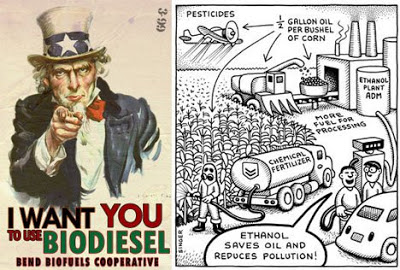By Justin Credible It seems there is no end in sight to the ever growing list of blunders promoted by well-funded Big Environment these days, ranging from yesteryears fraudulent Silent Spring propaganda banning DDT and causing millions of unnecessary deaths, promoting mistaken claims that the ice caps are shrinking, the recent oxygen depletion scare, and the past misguided promotion of
It seems there is no end in sight to the ever growing list of blunders promoted by well-funded Big Environment these days, ranging from yesteryears fraudulent Silent Spring propaganda banning DDT and causing millions of unnecessary deaths, promoting mistaken claims that the ice caps are shrinking, the recent oxygen depletion scare, and the past misguided promotion of green toxic CFL lightbulbs which led to their eventual mandated legislation in some countries. Of course, the biggest hoax, anthropogenic global warming, is still touted as a fact even though it’s merely a political myth and is the main driver of all these smaller sub-hoaxes. Yet, the man-made climate change propaganda campaign steams on, powered by Gorezilla and Obamania, although there is still a complete lack of scientific evidence to support the greenies absurd CO2-is-evil theory, plus an ever growing backlash of worldwide scientists who refute these alarmist claims and are aware of the fact the planet has been cooling for over a decade now and extreme weather is decreasing.
One of the latest agendas endorsed and promoted by the enviro-religious everywhere is the “alternate vehicle power” campaigns, most notably biofuel and hybrid-electric cars. Too bad the greens got these two causes all backwards too.
Let’s begin with biofuel. As reported in the Ottawa Citizen here in Canada, Prime Minister Stephen Harper recently announced a $1.5-billion, nine-year plan to make Canada a leader in biofuel production, regardless of the widespread concern about the so-called “green” energy boom, which is having a serious environmental impact around the globe as forests are leveled and farm land is set aside to grow biofuel crops. Once again, the third world will especially suffer under this system, much like all the other morally irresponsible policies designed to fight off an imaginary man-made climate change.
“In all cases, forestation of an equivalent area of land would sequester two to nine times more carbon over a 30-year period than the emissions avoided by the use of the biofuel,” says a report published in the journal Science by Renton Righelato of the World Land Trust and Dominick Spracklen of the University of Leeds. To put it simply, “the emissions cost of liquid biofuels exceeds that of fossil fuels.”
They note energy crops require an enormous amount of land: to replace just 10 per cent of gasoline and diesel fuel would require an estimated 43 per cent of crop land in the U.S. and 38 per cent of crop land in Europe. And clearing grasslands and forests to grow energy crops releases carbon stored in existing vegetation and soil and creates large up-front emissions that the report says would “outweigh the avoided emissions.”
Indeed, the global alarmists say they want to reduce CO2 emissions because they mistakingly believe CO2 causes global warming AKA climate change and have not yet come to accept that CO2 is actually a harmless trace gas and an invaluable plant food which sustains all life on Earth and has nothing to do with pollution or “climate change”. But just for fun, let’s put that annoying fact aside and play the green game and pretend that reducing CO2 is actually a good thing. Well, damnit, biodiesel does indeed emit less than one-quarter the carbon of regular diesel once it’s burned, however when production commences and the destruction of ecosystems in the developing countries where most biofuel crops are grown is factored in, many biofuels actually emit more carbon than does petroleum, as was also widely reported last year.
Furthermore, oil palms don’t absorb as much CO2 as the rainforest or peatlands they replace, palm oil can generate as much as 10 times more carbon than petroleum, according to the advocacy group Food First.
So, biofuels produce more CO2 than regular fuels. And they push starvation levels up! Oh snap! Now, while most respected scientists around the world understand that the Earth is currently CO2 impoverished and creating more of it is actually a GOOD THING, I’m sure many environmentalists are going to quietly back away from promoting their biofuel fantasy once they wake up to reality, if that ever happens.
But wait, says Bradley Doucet, there’s more!
“We are, by all accounts, in the midst of a global food crisis. “A wave of food-price inflation is moving through the world, leaving riots and shaken governments in its wake,” says an article in the April 19 edition of The Economist. In the last year, the price of corn has risen 50%, wheat 75%, and rice nearly 200% (see “The New Face of Hunger“). The president of the World Bank figures that 100 million people are in danger of being forced into poverty by the soaring cost of food. UN Secretary General Ban Ki-moon met with key development agencies in Switzerland at the end of April to discuss what to do about the problem.
 The current crisis is not one of supply – there have been no massive, widespread harvest failures – but rather of demand. One might well imagine that as millions become richer in places like China and India, they are exerting upward pressure on food prices by eating more. In fact, though this is happening, it is happening only gradually. The high price of oil is also having an overall inflationary effect, as is the U.S. Federal Reserve’s loosening of the money supply in reaction to the subprime lending fiasco. But the real culprit behind the recent rapid upswing in food prices, according to The Economist, is “the sudden, voracious appetites of western biofuels programmes, which convert cereals into fuel.”
The current crisis is not one of supply – there have been no massive, widespread harvest failures – but rather of demand. One might well imagine that as millions become richer in places like China and India, they are exerting upward pressure on food prices by eating more. In fact, though this is happening, it is happening only gradually. The high price of oil is also having an overall inflationary effect, as is the U.S. Federal Reserve’s loosening of the money supply in reaction to the subprime lending fiasco. But the real culprit behind the recent rapid upswing in food prices, according to The Economist, is “the sudden, voracious appetites of western biofuels programmes, which convert cereals into fuel.”
Diverting crops like corn to ethanol refineries increases the demand for corn, which raises the price of corn. This in turn causes some farmers to shift fields to corn production, and some consumers to substitute away from corn, both of which raise the prices of other staples. Jean Ziegler, an independent food expert at the UN, told the recent Swiss conference:
“biofuels, as they are produced at present, constitute ‘a crime against a large part of humanity.'”
He was not alone in singling out biofuels. Also at the conference, Céline Charvériat, Oxfam International’s deputy advocacy director, said that biofuels are “a major cause of increasing prices” and called on rich countries to end their biofuels mandates.
But if consumers in rich countries want biofuels, then that’s what they want, and markets will just have to adjust, right? Except that it’s not consumers who are choosing to use biofuels in a free market – it’s governments that are pushing biofuels on consumers with market-distorting mandates and subsidies. According to an article by Robert Bryce published in Slate in 2005, subsidizing ethanol “has cost American taxpayers billions of dollars during the last three decades, with little to show for it. It also shovels yet more federal cash on the single most subsidized crop in America, corn. Between 1995 and 2003, federal corn subsidies totaled $37.3 billion.” Things have only gone from bad to worse since then, as mandates and subsidies for ethanol have been ratcheted up dramatically.
Take away those subsidies, and even with the current high price of oil, nobody but the most fervent environmentalist is buying ethanol. Subsidies by their very nature take money from taxpayers and spend it on things the taxpayers would not have spent it on – eit her that, or they do nothing at all and are completely pointless. If ethanol is a way to address the imaginary global warming, replace dwindling oil supplies (even though there is no oil shortage whatsoever), or achieve energy independence, then people either value these goals highly enough to pay the difference at the pump or they don’t. Forcing those who don’t to act against their values through tax-funded subsidies is like burning money.
her that, or they do nothing at all and are completely pointless. If ethanol is a way to address the imaginary global warming, replace dwindling oil supplies (even though there is no oil shortage whatsoever), or achieve energy independence, then people either value these goals highly enough to pay the difference at the pump or they don’t. Forcing those who don’t to act against their values through tax-funded subsidies is like burning money.
The truth is quite sad. Biofuels such as ethanol have become the trendy way for politicians and corporations to show they’re serious about finding alternative sources of energy and in the process slowing their manufactured ‘global warming crisis’. It’s a win-win for governments and alarmists alike. But all is clearly not as it seems. Biofuels, it turns out, are bad for people, bad for prosperity, and bad for the planet.
Come on people, wake up. Clear-cutting forests for biofuels is not only foolhardy, it’s downright disgusting. And, it effectively produces more of those “evil” CO2 emissions that the warmists claim it reduces. Strike one!
HYBRID VEHICLES
Oh heavens, where do I begin?! Unless you’ve been living under a rock and have brainlessly bought into the force-fed propaganda via the enviro cults and their green orthodoxy (cough), you would already know that hybrids (which run on combined electric and either gas or diesel) are incredibly detrimental to the environment to produce and ultimately create more CO2 than vehicles powered by just good ol’ internal combustion engines. What’s that you say? You weren’t aware of all this? Read on my friends.
Firstly, the additional materials used in the manufacture of hybrid cars, particularly the nickel used in the batteries, is actually enormously bad for the environment. Plus, it takes more combined energy to produce a Toyota Prius than to produce a Hummer. FACT, not fiction!

A little hybrid lesson: The Prius is powered by not just one, but two engines. Both a standard 76 horsepower, 1.5-liter gas engine found in most cars today and a battery- powered engine that deals out 67 horsepower and a whooping 295ft/lbs of torque, below 2000 revolutions per minute. The Toyota “Synergy Drive” system, as they call it, propels the car from a dead stop to up to 30mph. This is where the largest percent of gasoline is consumed. As any physics professor can tell you, it takes more energy to get an object moving than to keep it moving.
The battery is recharged through the braking system, as well as when the gasoline engine takes over anywhere north of 30mph. Aside from the batteries, it seems like a great energy efficient and environmentally sound car, right? Wrong. As Chris Demorro reported on The Recorder:
“You would be right if you went by the old government EPA estimates, which netted the Prius an incredible 60 miles per gallon in the city and 51 miles per gallon on the highway. Unfortunately for Toyota, the government realized how unrealistic their EPA tests were, which consisted of highway speeds limited to 55mph and acceleration of only 3.3 mph per second. The new tests which affect all 2008 models give a much more realistic rating with highway speeds of 80mph and acceleration of 8mph per second. This has dropped the Prius EPA rating down by 25 percent to an average of 45mpg. This now puts the Toyota within spitting distance of cars like the Chevy Aveo, which costs less then half what the Prius costs.”
Okay, with that being said, let’s go back to point one: building a Toyota Prius causes more environmental damage than a Hummer. As already noted, the Prius is partly driven by a battery which contains nickel. The nickel is mined and smelted at a plant in Sudbury, Ontario. This plant has caused so much environmental damage to the surrounding environment that NASA has used the “dead zone” around the plant to test their moon rovers. The area around the plant is devoid of any life for miles!
As if I needed to make the point stronger, I will anyways. Did you know that a Hummer is on the road for an average of three times longer than a Prius? Exactly how is it environmentally responsible to have to buy three cars in the same time frame as one would have served? And before someone starts raving about how they save money on gas, just wait until it’s time to replace those multi-thousand-dollar toxic batteries every few years. You would’ve saved far more cash by sticking with gas!
HUMMER vs PRIUS: Download the Pacific Institute’s seven page re-analysis of “Dust to Dust”
What about 100% electric cars? Umm yeah….gotta plug those thirsty batteries in every night, and where’s that power coming from? That’s right: mostly coal. If hundreds of millions of electric vehicles needed to be recharged every day, the CO2 emissions feared so much would skyrocket. Oh, and good luck with those fairyland solar panels and bird-killing windmills being able to support that kind of demand.
It also doesn’t take a rocket scientist to point out that hundreds of pounds of giant batteries are necessary to briefly move an entire vehicle with passengers and subsequently the weight of said batteries, whilst a couple drops of gasoline will do the same thing. So, which one is really more efficient? I’m not saying the internal combustion engine can’t be improved — in fact it can be made much more efficient if necessary. Yes, big oil is probably against higher efficiency. Yes, big oil is gouging us at the pumps. No, the alternatives are not better. They are far worse.
Biofuels and hybrids? Just two more strikes against the hysteria-driven and increasingly illogical “green” movement.